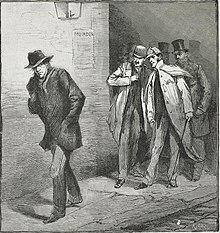| Jack the Ripper |
|---|

"With the Vigilance Committee in the East End:
A Suspicious Character" from
The Illustrated London News,
13 October 1888 |
Background information |
|---|
| Birth name | Identity unknown |
|---|
| Also known as | "The Whitechapel Murderer"
"Leather Apron" |
|---|
| Killings |
|---|
| Number of victims | 5+? |
|---|
| Country | United Kingdom
|
|---|
"
Jack the Ripper" is the best-known name given to an unidentified
serial killer who was active in the largely impoverished areas in and around the
Whitechapel district of London in 1888. The name originated in
a letter, written by someone claiming to be the murderer, that was disseminated in the media. The letter is widely believed to have been a hoax, and may have been written by a journalist in a deliberate attempt to heighten interest in the story. Other nicknames used for the killer at the time were "The Whitechapel Murderer" and "Leather Apron".
Attacks ascribed to the Ripper typically involved female prostitutes from the slums whose throats were cut prior to abdominal mutilations. The removal of internal organs from at least three of the victims led to proposals that their killer possessed anatomical or surgical knowledge. Rumours that the murders were connected intensified in September and October 1888, and letters from a writer or writers purporting to be the murderer were received by media outlets and
Scotland Yard. The
"From Hell" letter, received by
George Lusk of the
Whitechapel Vigilance Committee, included half of a preserved human kidney, supposedly from one of the victims. Mainly because of the extraordinarily brutal character of the murders, and because of media treatment of the events, the public came increasingly to believe in a single serial killer known as "Jack the Ripper".
Extensive newspaper coverage bestowed widespread and enduring international notoriety on the Ripper. An investigation into a series of brutal
killings in Whitechapel up to 1891 was unable to connect all the killings conclusively to the murders of 1888, but the legend of Jack the Ripper solidified. As the murders were never solved, the legends surrounding them became a combination of genuine historical research, folklore, and
pseudohistory. The term "ripperology" was coined to describe the study and analysis of the Ripper cases. There are now over one hundred
theories about the Ripper's identity, and the murders have inspired
multiple works of fiction.
